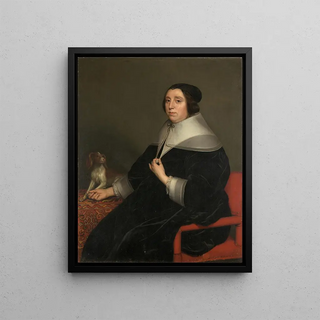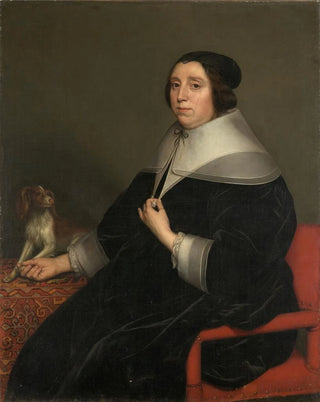Art print | Portrait of a woman - Gerard van Honthorst


View from behind

Frame (optional)
Gerard van Honthorst's "Portrait of a Woman" is a piece that transcends the simple frame of painting to become a true window into the human soul. This 17th-century artwork reflects an era when art was not only a means of expression but also a mirror of societal values and aspirations. By immersing oneself in this piece, the viewer is invited to explore not only the beauty of the subject but also the technical mastery of the artist, who manages to capture light in a striking way, endowing her with an almost mystical aura.
Style and uniqueness of the work
van Honthorst's style is distinguished by its bold use of chiaroscuro, a technique that highlights the contrasts between light and shadow. In the "Portrait of a Woman," this approach is executed with such finesse that it brings the face of the depicted woman to life. The delicate shadows caressing her features emphasize her contemplative expression, while the radiant light illuminating her gaze creates a powerful emotional connection with the viewer. The color palette chosen by the artist, rich and nuanced, also contributes to the depth of the work, making every detail, from her dress fabric to her skin texture, highly precise. This painting does not merely depict a female figure; it tells a story, that of a woman who is both strong and vulnerable, her gaze seemingly questioning the world around her.
The artist and his influence
Gerard van Honthorst, born in Utrecht, is often associated with the Dutch school of the 17th century, a period when art experienced unprecedented growth. Influenced by Caravaggio, he developed a style that combines realism and drama, capturing moments of rare emotional intensity. van Honthorst is not limited to portrait painting; he also excels in genre scenes and religious compositions, each of his works revealing a deep understanding of human traits. His impact on his contemporaries and subsequent generations is undeniable. By incorporating elements of daily life and authentic expressions into his portraits, he paves the way for a new artistic approach that values

Matte finish

View from behind

Frame (optional)
Gerard van Honthorst's "Portrait of a Woman" is a piece that transcends the simple frame of painting to become a true window into the human soul. This 17th-century artwork reflects an era when art was not only a means of expression but also a mirror of societal values and aspirations. By immersing oneself in this piece, the viewer is invited to explore not only the beauty of the subject but also the technical mastery of the artist, who manages to capture light in a striking way, endowing her with an almost mystical aura.
Style and uniqueness of the work
van Honthorst's style is distinguished by its bold use of chiaroscuro, a technique that highlights the contrasts between light and shadow. In the "Portrait of a Woman," this approach is executed with such finesse that it brings the face of the depicted woman to life. The delicate shadows caressing her features emphasize her contemplative expression, while the radiant light illuminating her gaze creates a powerful emotional connection with the viewer. The color palette chosen by the artist, rich and nuanced, also contributes to the depth of the work, making every detail, from her dress fabric to her skin texture, highly precise. This painting does not merely depict a female figure; it tells a story, that of a woman who is both strong and vulnerable, her gaze seemingly questioning the world around her.
The artist and his influence
Gerard van Honthorst, born in Utrecht, is often associated with the Dutch school of the 17th century, a period when art experienced unprecedented growth. Influenced by Caravaggio, he developed a style that combines realism and drama, capturing moments of rare emotional intensity. van Honthorst is not limited to portrait painting; he also excels in genre scenes and religious compositions, each of his works revealing a deep understanding of human traits. His impact on his contemporaries and subsequent generations is undeniable. By incorporating elements of daily life and authentic expressions into his portraits, he paves the way for a new artistic approach that values






